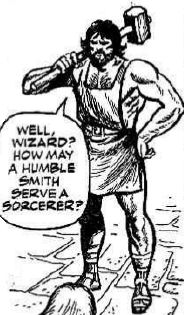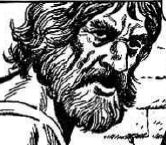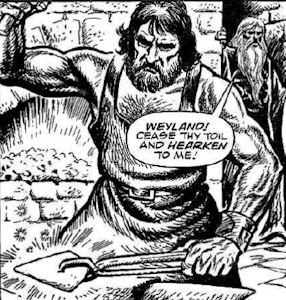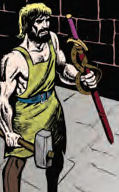 Real Name: Weyland Vadisson
Real Name: Weyland Vadisson
WEYLAND
 Real Name: Weyland Vadisson
Real Name: Weyland Vadisson
Identity/Class: Demigod (see comments)
Occupation: Blacksmith
Group Membership: Residents of Camelot
Affiliations:
Merlyn;
indirectly Black Knight (Dane Whitman);
legends Beowulf, Flittergibbet, Mimir (probably not
this
Mimir),
Waltere of Aquitaine
Enemies:
Necromon;
legends Amilias, King Nidud, Siegfried (possibly this
Siegfried)
Known Relatives: Legends Vadi (father,
deceased);
Egil, Slagfid (brothers),
Swanhilde (a.k.a.
Hervör Allwise, a.k.a. Hildegarde, first wife, separated), Bodvild (second
wife);
Viderik Verlandsson (a.k.a. Vidigoia), Heime (sons);
Olrun, Hlaðguðr
Swanwhite (sisters-in-law);
Hlödvér (first father-in-law), Nidud
(second father-in-law, deceased);
Otvin (brother-in-law) two unidentified
brothers-in-law (deceased);
Kjárr of Valland
(uncle-in-law)
Aliases: Prince of demons;
variations on his real name: Galans, Velentr, Völundr,
Wayland Smith, Weyland Smith, Welandaz, Wieland der Schmied,
Wiolant
Base of Operations: Probably New Camelot,
Otherworld;
formerly Camelot, Otherworld;
formerly Wayland's Smithy, Berkshire Downs,
U.K., Earth;
formerly Wolfdale, Scandinavia, Earth
First Appearance: (Marvel) The Incredible Hulk (UK; aka Hulk Weekly; see comments) I#60 (24th April 1980)
Powers/Abilities: Weyland is an unsurpassed blacksmith of legendary skill, able to forge items of immense magical power, from powerful weapons to indestructible armor to delicate jewelry. By dint of working daily pounding metal, he is extremely strong, perhaps superhumanly so. He wields a great hammer whilst forging, which might double up as a lethal weapon if required. He is a skilled swordsman and hunter.
 Height:
6'6" (by approximation)
Height:
6'6" (by approximation)
Weight: 235 lbs. (by approximation)
Eyes: Unrevealed
Hair: Black
History:
(ancient poems and myth) - Weyland and his brothers Egil and Slagfid were
the sons of the God-giant Vadi, king of the Finns. Vadi sent Weyland to
apprentice under the master smith Mimir in Húnaland, but when he learned
that another of Mimir's apprentices, Siegfried, regularly beat his fellows,
he brought Weyland home and sent him instead to learn his craft from two
skilled dwarves who resided within the mountain Kallava. Despite agreeing
to teach him all they knew, they grew jealous of his skills and threatened
to kill him unless his father took him back by an agreed time; when Vadi
was killed in an avalanche, Weyland prevented the dwarves from carrying out
their threat by slaying them first.
Hollowing out a tree to create a boat, Weyland sailed across the sea to a land ruled by King Nidud, where he was soon accepted into the royal court, but the miserly king proved a dishonorable employer, reneging on one promise after another. One day Weyland lost the king's knife, so he secretly made another, but the king became suspicious when he noticed the knife now cut through things better than it had before. When he questioned Weyland, the smith lied and said it had been made by the royal smith Amilias, whose jealousy towards Weyland had sparked a feud between them. Suspicious, Nidud decided on a test; Amilias was to forge his best armor, while Weyland was to forge a sword with which he was to try and slay Amilias while his rival wore said armor. Weyland secretly made two visually identical swords, one that used all his skills and that he named Mimung, and the other that was merely ordinary. Mimung was so sharp that it sliced through Amilias and his armor so easily that he didn't even realize he had been cut until Weyland told him to move, at which point Amilias split into two and died. Sure enough, Nidud claimed Mimung for himself, unaware that Weyland switched the swords and had given him the copy.
During a war expedition, Nidud realized he had forgotten his magical victory stone Siegerstein, and in desperation offered his daughter Bodvild's hand and half the kingdom to anyone who could bring it to him by sunset. Weyland did so, but when he tried to deliver it to the king, another knight, the king's senechal, desirous of Bodvild and the kingdom, demanded Weyland surrender the stone to him. A fight ensued, ending with Weyland slaying the senechal. Angered by the loss of his knight, Nidud banished Weyland.
Weyland and his brothers subsequently built themselves a house in Wolfdale (Úlfdalir), and one morning by the nearby Wolf Lake spied three Valkyrior swan maidens who had removed their swan cloaks to spin linen. Successfully wooing the trio, each brother married one Valkyrie; Weyland married Swanhilde, while Slagfid married her sister Hlaðguðr and Egil married Olrun. Swanhilde bore Weyland a son, Heime, but though all three couples were happy, the wives still found it hard to stay in the mortal world; by the eighth year the women could feel the pull to attend battles, and in the ninth they succumbed to the need to fulfill their fate, became swans again and flew away while their husbands were out hunting. Swanhilde left her love her magical arm ring to remember her by. Distraught, Egil skied eastwards to hunt for his love, while Slagfid headed south, but Weyland was sure Swanhilde would return and so decided to wait at Wolfdale, spending his time forging seven hundred duplicate rings from red gold, stringing them on ropes of bast.
Word reached Nidud of Weyland's horde, and that he was now living alone in the woods, without his siblings to back him up, so Nidud went with his soldiers to Wolfdale. Arriving while Weyland was out hunting, the king decided to search the lodge. Fascinated by the rings, he examined each in turn, and was so struck by the beauty of Swanhilde's that he couldn't bring himself to replace it. Telling his men to wait to capture Weyland upon his return (and then steal the rest of the jewelry), Nidud returned to his kingdom. When Weyland returned (having slain a bear to eat!), he counted the rings, and upon noticing one missing believed that Swanhilde had returned and taken it. He sat up through the night waiting for her, but when he eventually fell asleep, the king's warriors bound him while he slumbered. Waking in chains, Weyland was taken back to Nidud's kingdom, where the king appropriated Mimung and gave Swanhilde's ring to Bodvild. Seeing the rage in Weyland's eyes at witnessing this theft Nidud's wife grew fearful of the smith's revenge, and ordered the soldiers to cut his tendons. Rendered lame, Weyland was imprisoned on the island of Sævarstöð (the House on the Lake) and forced to forge jewelry for Nidud.
At first only the king was allowed to visit Weyland, but after several years Nidud's two younger sons grew covetous of the wealth coming out of the forge and arranged to visit the "prince of demons" held prisoner on the island. Weyland used this visit to lull the two young men into a false sense of security, telling them to come back that night without informing anyone of this second visit so they could take away all of the treasures he had made. When they did, he distracted them with a chest full of jewelry and decapitated them both with a sword he had forged that afternoon. Wanting to show to Nidud that true wealth came from family, not possessions, Weyland hid his victim's bodies under his forge, coated their skulls in silver to fashion goblets which he presented to Nidud, cast their eyes inside gemstone for the queen, and turned their teeth into two brooches for Bodvild.
While search parties scoured the countryside for the missing princes, their sister Bodvild visited the forge, having broken Swanhilde's ring. Scared at how her father might react, she had secretly brought it to Weyland for repair. Plying her with wine, he seduced her, leaving her pregnant, something she hid in terror from her father. Soon after this, Weyland's brother Egil came to Nidud's kingdom. Knowing of Egil's reputation as a renowned archer, and unaware he was Weyland's brother, Nidud challenged Egil to shoot an arrow off the head of his remaining son, Otvin. Though only permitted one shot, Egil prepared two arrows, and after he succeeded with his first shot, the king asked him why he had needed the other; Egil replied that had he accidentally shot the king's son, he would have used the second to slay the king. Commending Egil for his openness, Nidud permitted him to stay at the court. Egil then secretly smuggled feathers from birds he killed to Weyland, who used them to fashion a pair of wings. Weyland then flew to Nidud's home, confronting him alone in his bedchamber. Now suspecting Weyland's part in his sons' disappearance, Nidud begged to know their fates, allowing Weyland to extract from the king a promise not to harm his bride (presumably meaning Bodvild in this instance). Once he had that, Weyland regaled Nidud with a full account of his gruesome revenge. As he flew away, Nidud ordered Egil to shoot him down, still unaware of the archer's part in things. Egil appeared to comply, but actually hit a bladder filled with blood Weyland had hidden under his arm, fooling the king and allowing Weyland to return home without fear of retribution. Stricken with sorrow, Nidud sent for his daughter, who tearfully admitted her pregnancy. Grief stricken, Nidud died soon after, and Otvin ascended the throne. More pragmatic than his father, Otvin made peace with Weyland, marrying him to Bodvild, who bore Weyland another son, Vederik, who would go on to become a great hero in his own right.
Many of Weyland's creations would go on to serve future heroes well: Mimung made its way into the hands of Walter of Aquitaine, the Viking Thorsten got hold of the sword Gram and a magic ring, and Beowulf a mail shirt.
Eventually, seemingly wishing to hide from men, Weyland came to England, and set up a secret forge within a barrow in White Horse Hill on the Berkshire Downs, a place that became known as Wayland's [sic] Smithy. Allegedly having become a king of the elves, legends spread of an invisible smith who would shoe any horse left there overnight, so long as a coin was left in payment and the owner absented themselves. He took on an apprentice, Flittergibbet, whom he would send to fetch nails for his shoeing, but he constantly annoyed Weyland with his silliness, until the exasperated smith threw him down into the valley, turning him to stone.
One special horse that Weyland shod belonged to the Norse hero Sigurd, resulting in it becoming frozen in chalk as a giant hill figure near his smithy. However, every hundred years it awakes, jumps off the hill and runs back to the smithy for him to shoe again.
 (The
Incredible Hulk (UK) I#60 (fb) - BTS) - Weyland eventually made his way to
Otherworld, where he set up his forge in the depths of Castle
Camelot.
(The
Incredible Hulk (UK) I#60 (fb) - BTS) - Weyland eventually made his way to
Otherworld, where he set up his forge in the depths of Castle
Camelot.
(The Incredible Hulk (UK) I#60) - As the threat of Necrom loomed, Merlyn visited him there and asked him to reforge the broken pieces of the Ebony Blade, shattered when the Black Knight fought the Iron Ogre, telling the smith that as well as reworking, it needed binding with a great spell.
(The Incredible Hulk (UK) I#61) - Weyland finished his work just in time, making the blade stronger than it had been before. As Necromon's forces gathered outside Camelot, Weyland delivered the repaired sword to Merlyn, to hold for the Black Knight until he returned from a vital mission.
 (The Incredible Hulk (UK) I#62-63 - BTS) - Weyland presumably took
part in the battle for Camelot against Necromom's army.
(The Incredible Hulk (UK) I#62-63 - BTS) - Weyland presumably took
part in the battle for Camelot against Necromom's army.
Comments: Created by Steve Parkhouse, Paul Neary and John Stokes.
A small note regarding his UK comics appearances
- the comic he appeared in was titled on the cover as "The Incredible Hulk,"
but the indicia called it "Hulk Weekly"; since the first name is the
one people would be looking for if they were searching for it by checking
covers, I've used that here, but some online sites list it by the latter;
ymmv.
The legend of Weyland date at least as far back as the 8th century A.D., with a carving of him to be found on the Anglo-Saxon "Franks Casket" currently held in the British museum. His story is told in various forms across Scandinavian, Old English and Germanic mythology including Velents þáttr smiðs (The short story of Völund the Smith) and the Poetic Edda's Volundarkviða (Lay of Völundr), as well as the Old English poem Deor. Weyland is also referenced in the epic poems Waldere (a.k.a. Walter of Aquitaine, king of the Visigoths) and Beowulf for forging each heroes' legendary weapons.
As the more mythologically inclined may notice, the pre-Marvel history is a mixture of the various sagas about Weyland. While the overall tale remains the same, some details vary from one account to the next. A few are some comparatively minor in the narrative sense: in some versions he rapes Bodvild rather than seducing her, and there's a lot of regional/language variations related to names - I've used the ones with the fewest accents not common to standard English, just for ease of reading. Some are more noticeable: Weyland works for Nidud and ends up imprisoned after returning from exile in attempt to kill him versus Weyland never sailed to Nidud's kingdom and was simply kidnapped for his gold and skills. In one version, he kills Amilias after being kidnapped, but other versions don't mention Amilias at all. When stories in the comics appear to contradict themselves, it's handbook policy to see if we can make as much as possible fit, so I've taken that approach here, meaning that where the versions differ I've tried to keep as much from both as I could, and to go with the versions that made him come across as less of a jerk. He's among the heroes in Hulk Weekly, so I think we should go with the versions of the legends where he (a) doesn't rape Bodvild and (b) wasn't imprisoned because he tried to murder Nidud for sacking him. I apologize if this blended legend approach offends purists.
What type of god is Weyland?
More Norse/Scandanavian/Danish/Germanic/Icelandic mythology, that then came over to England with the Angles, Saxons and Vikings (the former two being the Germanic sides, and the later one covering all the other regions), part of what became known as the Danelaw (as in Danish law). Tuatha were more Celtic, so Ireland, Scotland (Scots actually being an Irish tribe to begin with), and other Celtic countries like France (though the Franks, who gave their name to the country, were a German tribe who invaded - European tribes did keep migrating/invading one another, so it's all a bit mixed together - the Gauls, previous inhabitants of what became known as France, were the Celts iirc).
There really is a Neolithic stone burial chamber called Wayland's Smithy located near the Uffington White Horse (a gigantic prehistoric hill figure of a stylized horse, created by filling trenches with crushed white chalk) in Oxfordshire, and an actual legend about Wayland shoeing any horse left there.
The Valkyrior handbook entry confirms that Hildegarde is also known as Svanhild, which means she's presumably Swanhilde, Weyland's first wife. Hlaðguðr Swanwhite is said to be her sister and fellow Valkyrie, suggesting she is Krista, Hildegarde's sister. The third Valkyrie who married Egil is harder to peg; the closest name to Olrun is Ortlinda, but only in terms of beginning with an O. Nevertheless, since Ortlinda is thus far the only Valkyrior not to have multiple aliases, she still seems the best bet; why should she be left out of the multiple name game?
Given his mythological roots, it's not surprising that others have also added the character to their tales, especially those that deal with British mythology. Weyland Smith turns up in Vertigo's Fables and as John Wayland Smith in Susan Cooper's Dark is Rising novel series - I heartily recommend both as excellent reads!
Profile by Loki.
CLARIFICATIONS:
Weyland has no known connections to:
images: (without ads)
The Incredible Hulk (UK) I#60, p8/p3 of Black Knight, pan 8 (main image)
The Incredible Hulk (UK) I#60, p8/p3 of Black Knight, pan 10 (headshot)
The Incredible Hulk (UK) I#60, p8/p3 of Black Knight, pan 7 (working at his
forge)
The Incredible Hulk (UK) I#61, p8/p2of Black Knight, pan 1 (handing over
the reforged Ebony Blade; colorized version from OHOTMU Otherworld
entry)
Appearances:
The Incredible Hulk (UK) I#60-61 (24th April-1st May 1980) - Steve Parkhouse
(writer), Paul Neary and John Stokes (art), Paul Neary (editor)
First Posted: 02/02/2019
Last updated: 02/02/2019
Any Additions/Corrections? please let me know.
Non-Marvel
Copyright info
All other characters mentioned or pictured are ™ and © 1941-2099
Marvel Characters, Inc. All Rights Reserved. If you like this stuff, you
should check out the real thing!
Please visit The Marvel Official Site at:
http://www.marvel.com
Special Thanks to www.g-mart.com for hosting the Appendix, Master List, etc.!